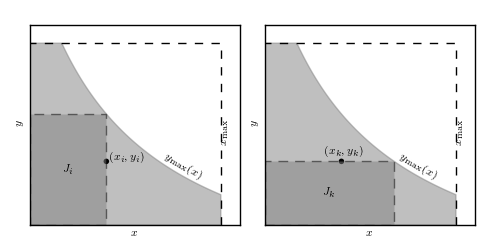Lynden-Bell C- setup¶
Figure 4.8.
Illustration for the definition of a truncated data set, and for the comparable or associated subset used by the Lynden-Bell C- method. The sample is limited by x < xmax and y < ymax(x) (light-shaded area). Associated sets Ji and Jk are shown by the dark-shaded area.

# Author: Jake VanderPlas
# License: BSD
# The figure produced by this code is published in the textbook
# "Statistics, Data Mining, and Machine Learning in Astronomy" (2013)
# For more information, see http://astroML.github.com
# To report a bug or issue, use the following forum:
# https://groups.google.com/forum/#!forum/astroml-general
import numpy as np
from matplotlib import pyplot as plt
from matplotlib.patches import Rectangle
#----------------------------------------------------------------------
# This function adjusts matplotlib settings for a uniform feel in the textbook.
# Note that with usetex=True, fonts are rendered with LaTeX. This may
# result in an error if LaTeX is not installed on your system. In that case,
# you can set usetex to False.
from astroML.plotting import setup_text_plots
setup_text_plots(fontsize=8, usetex=True)
#------------------------------------------------------------
# Draw the schematic
fig = plt.figure(figsize=(5, 2.5))
fig.subplots_adjust(left=0.06, right=0.95, wspace=0.12)
ax1 = fig.add_subplot(121, xticks=[], yticks=[])
ax2 = fig.add_subplot(122, xticks=[], yticks=[])
# define a convenient function
max_func = lambda t: 1. / (0.5 + t) - 0.5
x = np.linspace(0, 1.0, 100)
ymax = max_func(x)
ymax[ymax > 1] = 1
# draw and label the common background
for ax in (ax1, ax2):
ax.fill_between(x, 0, ymax, color='gray', alpha=0.5)
ax.plot([-0.1, 1], [1, 1], '--k', lw=1)
ax.text(0.7, 0.35, r'$y_{\rm max}(x)$', rotation=-30)
ax.plot([1, 1], [0, 1], '--k', lw=1)
ax.text(1.01, 0.5, r'$x_{\rm max}$', ha='left', va='center', rotation=90)
# draw and label J_i in the first axes
xi = 0.4
yi = 0.35
ax1.scatter([xi], [yi], s=16, lw=0, c='k')
ax1.text(xi + 0.02, yi + 0.02, ' $(x_i, y_i)$', ha='left', va='center')
ax1.add_patch(Rectangle((0, 0), xi, max_func(xi), ec='k', fc='gray',
linestyle='dashed', lw=1, alpha=0.5))
ax1.text(0.5 * xi, 0.5 * max_func(xi), '$J_i$', ha='center', va='center')
# draw and label J_k in the second axes
ax2.scatter([xi], [yi], s=16, lw=0, c='k')
ax2.text(xi + 0.02, yi + 0.02, ' $(x_k, y_k)$', ha='center', va='bottom')
ax2.add_patch(Rectangle((0, 0), max_func(yi), yi, ec='k', fc='gray',
linestyle='dashed', lw=1, alpha=0.5))
ax2.text(0.5 * max_func(yi), 0.5 * yi, '$J_k$', ha='center', va='center')
# adjust the limits of both axes
for ax in (ax1, ax2):
ax.set_xlim(0, 1.1)
ax.set_ylim(0, 1.1)
ax.set_xlabel('$x$')
ax.set_ylabel('$y$')
plt.show()
